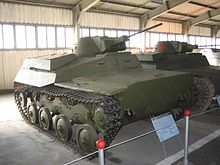
Back T-40 Azerbaijani Т-40 (танк) Bulgarian T-40 BS T-40 Catalan T-40 Czech T-40 (Panzer) German T-40 Spanish T-40 Estonian تی-۴۰ Persian T-40 French
| T-40 amphibious scout tank | |
|---|---|
 A normal T-40 rearmed with TNSh autocannon (foreground) and "T-40" T-60 (background) in the Kubinka Tank Museum. | |
| Type | Amphibious light tank |
| Place of origin | |
| Service history | |
| In service | 1941–46 |
| Used by | |
| Wars | World War II |
| Production history | |
| Produced | 1940–41 |
| No. built | 962 (356 normal, 594 "T-40" T-60 and 12 "T-40" T-60-based rocket launchers) |
| Variants | BM-8-24 Katyusha, T-30/"T-40" T-60 light tank |
| Specifications ([1][2][3]) | |
| Mass | 5.9 t (6.5 short tons) |
| Length | 4.10 m (13.5 ft) |
| Width | 2.33 m (7.6 ft) |
| Height | 1.90 m (6.2 ft) |
| Crew | 2 |
| Armour | 4–13 mm (0.16–0.51 in) |
Main armament | 12.7 mm (0.50 in) DShK machine gun |
Secondary armament | 7.62 mm (0.300 in) DT machine gun |
| Engine | GAZ-202 85 hp (63 kW) |
| Power/weight | 12 hp/tonne |
| Suspension | torsion bar |
Operational range | 450 km (280 mi) |
| Maximum speed | 45 km/h (28 mph) |
The T-40 amphibious scout tank was an amphibious light tank used by the Soviet Union during World War II. It was armed with one 12.7 mm (0.5 in) DShK machine gun. It was one of the few tanks that could cross an unfordable river without a bridge.
It was primarily intended to equip reconnaissance units. A land-based version of the T-40, the T-30/"T-40" T-60, was produced, although was later replaced by the "true" T-60. The T-60 was cheaper, simpler, better-armed, and could fulfill most of the same roles, so T-40 production was halted.
The vehicle served mainly in Operation Barbarossa and the defense of Moscow, and it was rarely seen after that point, although it was used in Soviet training schools until 1946. A total 12 examples of the type were later fitted with Katyusha rocket launchers, firing 82 mm unguided rockets from a 24-rail launcher.
© MMXXIII Rich X Search. We shall prevail. All rights reserved. Rich X Search